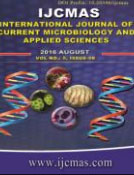


 National Academy of Agricultural Sciences (NAAS)
National Academy of Agricultural Sciences (NAAS)

|
PRINT ISSN : 2319-7692
Online ISSN : 2319-7706 Issues : 12 per year Publisher : Excellent Publishers Email : editorijcmas@gmail.com / submit@ijcmas.com Editor-in-chief: Dr.M.Prakash Index Copernicus ICV 2018: 95.39 NAAS RATING 2020: 5.38 |
This research study was carried to identify the mineralogical properties of the cracking clay soils (Vertisols) at the upper clay plains located at the north eastern parts of Nuba Mountains, Sudan. Soil samples were collected from profile pits along a toposequence in a transect stretching about 85 km from Samasim to Dalami. The area is an intermountain, slightly undulating clay plain surrounded by the Nuba mountains and hills. The majority of the soils identified belong to the dark cracking clays. The huge mantle of clay rests on the basement complex but the origin of this clay is somewhat controversial, it is either transported from another place and deposited were it is or formed in situ. According to previous studies, clay minerals particularly smectite are sensitive to pressure and temperature conditions and to variations in the chemical environment (sensitivity is expressed as crystallographic and mineralogical changes). Consequently, the study of clays can supply a great deal of information concerning the processes that occur in the evolution of the sequences of which they form a part such as weathering, hydrothermal alteration, digenesis, low grade metamorphism, etc. Furthermore, clay may reflect the history of the sediments better than any other component, because the characteristics of the clay minerals are to some extent subject to changes depending on the environment in which they are found. The x- ray diffraction (XRD) analysis was used to identify quantitatively and semi-quantitatively the proportion of each clay mineral with respect to other clay minerals present in the tested samples. The X – Ray diffraction analyses of samples in these profiles indicates that the dominant clay minerals is Smectite with percentages ranging between 84.6 - 49.5% followed by kaolinite 41.5 - 8.2%, chlorite 6.5 - 1.6%, illite 6.2 -2.1% and Semctite Chlorite 4.1 - 1.3%. The bulk mineral analysis indicate the present quartz minerals found in all profiles with percentages of 54.0, 48.0, 45.5, 32.8, 29.8, 35.4, 56.9, 61.6; mica is found in all 7 profiles except profile 10 with percentages of 46.0, 50.4, 41.8, 32.1, 70.1, 58.8, 41.6; silliminite present in profiles 16, 14, 11 with percentages of 1.6, 35.1, 1.5; Kaolinite present only in profile 15 with percentage of 12.3; calcite is found only in profiles 13, 10 with percentages of 0.1, 7.7 and magnetite exist in profiles 12 and 10 with percentages of 9.7, 30.6. In aggregates this mineralogical assemblages occurring in three areas suggest origins of parent materials derived from basic igneousmetamorphic rocks that have under gone weathering and in situ formation of clay minerals that have imposed magnitude of variations in the Pedological features.
 |
 |
 |
 |
 |